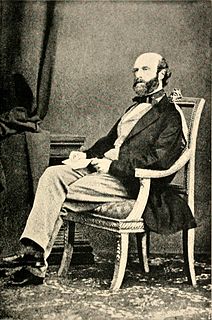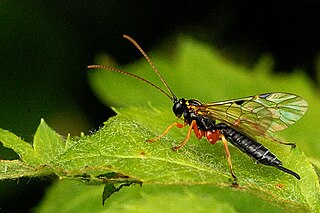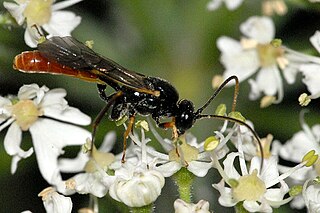| Idiogramma comstockii | |
|---|---|
 | |
| Female head, antero-ventral view | |
| Scientific classification | |
| Kingdom: | Animalia |
| Clade: | Euarthropoda |
| Class: | Insecta |
| Order: | Hymenoptera |
| Family: | Ichneumonidae |
| Genus: | Idiogramma |
| Species: | I. comstockii |
| Binomial name | |
| Idiogramma comstockii (Ashmead, 1895) | |
| Synonyms [1] [2] | |
Idiogramma comstockii is a species of wasp.
William Harris Ashmead initially described the species in 1895, and circumscribed a new genus, Lysiognatha, for it. [3] R. A. Cushman synonymized Lysiognatha with Idiogramma , making the species' name I. comstockii. [6]

William Harris Ashmead was an American entomologist born on 19 September 1855 at Philadelphia. He died 17 October 1908 at Washington D.C.
A species description is a formal description of a newly discovered species, usually in the form of a scientific paper. Its purpose is to give a clear description of a new species of organism and explain how it differs from species which have been described previously or are related. The species description often contains photographs or other illustrations of the type material and states in which museums it has been deposited. The publication in which the species is described gives the new species a formal scientific name. Some 1.9 million species have been identified and described, out of some 8.7 million that may actually exist. Millions more have become extinct.
In biological taxonomy, circumscription is the definition of a taxon, that is, a group of organisms.
The specific name honors John Henry Comstock, who sent Ashmead the specimens in the type series. Herbert Huntingdon Smith collected the specimens in 1872 at Cayuga Lake, Ithaca, New York. [3]
In zoological nomenclature, the specific name is the second part within the scientific name of a species. The first part of the name of a species is the name of the genus or the generic name. The rules and regulations governing the giving of a new species name are explained in the article species description.

John Henry Comstock was an eminent researcher in entomology and arachnology and a leading educator. His work provided the basis for classification of butterflies, moths, and scale insects.

Herbert Huntingdon Smith or Herbert Huntington Smith was an American naturalist and amateur conchologist who worked on the flora and fauna of Brazil. He wrote Brazil, the Amazons and the coast and Do Rio de Janeiro á Cuyabá: Notas de um naturalista (1922).
Its distribution includes Canada, the United States, and Northeast Mexico. [7]










